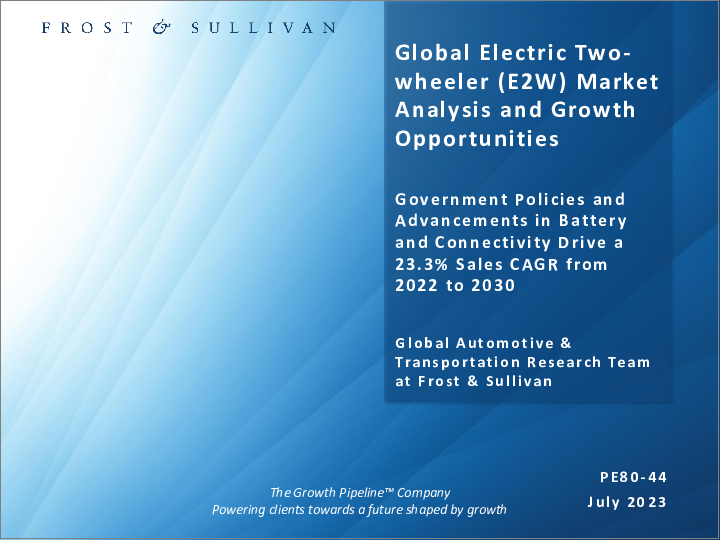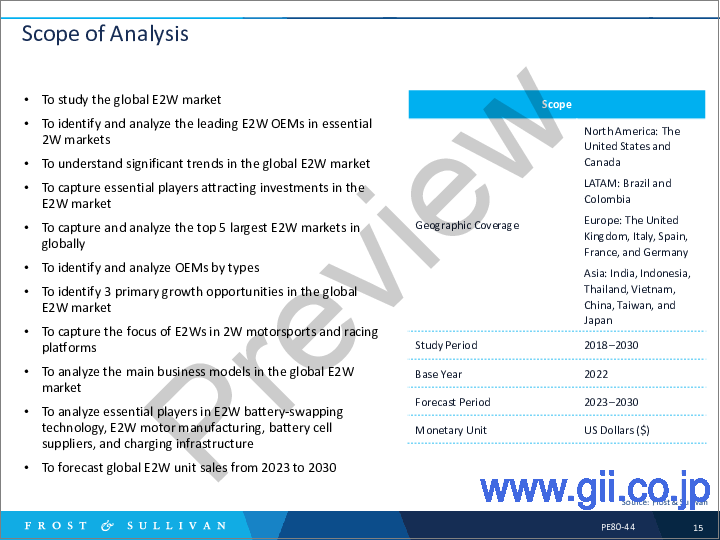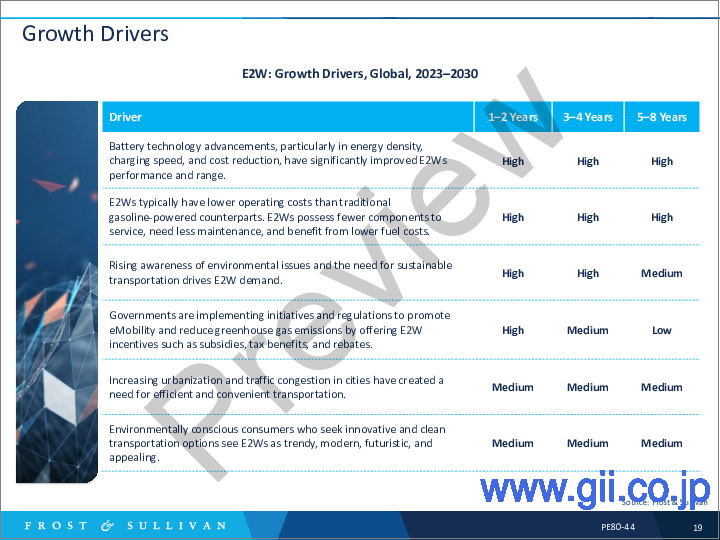|
|
市場調査レポート
商品コード
1322951
電動二輪車 (E2W) の世界市場の分析と成長機会Global Electric Two-wheeler (E2W) Market Analysis and Growth Opportunities |
||||||
|
|||||||
| 電動二輪車 (E2W) の世界市場の分析と成長機会 |
|
出版日: 2023年07月25日
発行: Frost & Sullivan
ページ情報: 英文 108 Pages
納期: 即日から翌営業日
|
- 全表示
- 概要
- 目次
政府の政策と、バッテリーとコネクティビティの進歩が、販売のCAGR (2022年~2030年) を23.3%に押し上げる
電動二輪車 (E2W) 市場に参入する新興企業、特に安価な部品を輸入して低品質の車両を販売する新興企業が増加しています。伝統的な内燃機関 (ICE) 二輪車 (2W) のメーカー (OEM) の大半は、まだE2W市場に参入していません。E2W技術は黎明期にあり、新興企業が大半を占めているため、他業界からの参入を誘致しています。
E2Wは、ICE 2Wに比べ、コンポーネント (主にソフトウェアで制御) の数が50%少ないため、修理やメンテナンスに必要な工具や時間が少なくて済みます。E2Wの新興企業は、運転コストを削減し、資金不足を回避して新たな投資家を惹きつけるために、より早く規模を拡大しようとしています。また、この市場の企業は、E2Wのメンテナンスを遠隔で行い、戸別修理サービスを提供できるため、実店舗をなくすために、顧客への直接販売やサービスといった新しいビジネスモデルを模索しています。より少ない投資でより早く各地域に拡大するためにOEMが精査しているその他の側面には、オンライン販売、訪問試乗、販売代理店との提携などがあります。
アジアやラテンアメリカ (LATAM) の国々は、E2Wの導入を促進するため、輸入政策を簡素化しています。政府は、品質基準を設定するために、より厳格な輸入政策と認証ルールを課すべきです。新興国は電気自動車 (EV) エコシステムの構築を促進するため、企業に有利な政策と政策を策定しています。E2Wの大手OEMは、政府とともにEVサプライチェーンを強化し、その国をEVハブにしようと努力しています。
Frost & Sullivanは本レポートで世界のE2W市場を調査しています。調査期間は2018年~2030年で、2022年を基準年、2023年~2030年を予測期間としています。対象地域は、北米 (米国、カナダ)、ラテンアメリカ (ブラジル、コロンビア)、欧州 (英国、イタリア、スペイン、フランス、ドイツ)、アジア (インド、インドネシア、タイ、ベトナム、中国、台湾、日本) です。アフリカやメキシコなど、その他の地域や国については、特定のトピックをより広くカバーするため、特定のスライドで言及しています。
その他の重要な情報は以下の通りです:
- 市場の主な動向:上位10件
- 地域別・タイプ別セグメント (eモペッド、eオートバイ、eスクーター)
- 主要OEM
- ビジネスモデル
- コンポーネントのエコシステム
Frost & Sullivanは、今後7年間のダイナミックなE2W分野でシェアを獲得するために、利害関係者が探索・活用できる洞察と成長機会を提供しています。
目次
戦略的課題
- なぜ成長が難しくなっているのか?
- The Strategic Imperative 8 (TM)
- E2W業界における戦略的課題:上位3項目のインパクト
- Growth Pipeline Engine (TM):成長機会による促進
成長環境
- 世界のE2W市場のスナップショット
- 主なE2Wモデルとそのモーター構造
- エントリーレベルのE2W:上位メーカー3社の比較分析
- E2W市場のバリューチェーン
- エコシステムの代表
- E2Wの成長と普及分析:主要国
- 主要競合企業:セグメント別
調査範囲
- 分析範囲
- E2Wのセグメンテーションと定義
- 地域別のセグメント
- 世界の注目すべきE2Wメーカー
成長機会分析
- 成長促進要因
- 成長抑制要因
- 予測の前提条件
- 調査手法
- 販売台数予測
- 主要競合企業:セグメント別
- E2W市場のバリューチェーン
- 販売台数比較
- 市場シェア:国別
- E2Wの販売台数が最も多い国:上位5ヶ国 (2022年)
- E2Wの成長・普及分析:主要国
- メーカーの種類
- E2Wメーカーの売上トップ3:タイプ別
- 主要E2Wメーカー:タイプ別および地域別
- エントリーレベルE2Wメーカー:上位3社の比較分析
- 中級E2Wメーカー:上位3社の比較分析
- 高級E2Wメーカー:上位3社の比較分析
- E2Wの販売・サービスのビジネスモデル
- E2W市場に参入する事業体のタイプ
- エコシステムの代表
- 最も売れているE2Wメーカー:上位3社、主要国の場合
- 世界の主要投資を集めるE2W新興企業
- 過去2年間の主な投資地域
- 地域別の成長機会:E2W新興企業への投資が活発化
市場の主な動向:上位10件
- 動向 1:eSIM (組み込み型加入者識別モジュール) による組み込み型テレマティクス
- 動向 2:センサーベースARASがE2Wの各セグメントに登場
- 動向 3:タッチスクリーンTFT多機能インフォテインメント・システム
- 動向 4:バッテリー交換技術
- 動向 5:固体電池技術
- 動向 6:サブスクリプション購入モデル
- 動向 7:3Dプリンティング
- 動向 8:PBV
- 動向 9:水素燃料電池式E2W
- 動向 10:D2C販売・サービス
E2Wコンポーネントのエコシステム
- E2Wのエコシステム
- E2Wモーター構造の種類
- 主なE2Wのモデルとそのモーター構造
- モーターメーカー
- E2Wの電池セル化学
- 人気のE2Wモデルとその電池セル化学
- E2Wバッテリー化学の適合性マトリックス
- E2Wバッテリーの進化と厳選されたセルメーカー
- バッテリーのリサイクル
- 注目すべき点
- バッテリー交換技術の利点:OEMとスワッピングステーションの視点
- バッテリー交換コンソーシアムの形成
- E2Wバッテリー交換コンソーシアムとそのメンバー
- E2Wの充電インフラ:概要、主要企業、ビジネスチャンス、今後の展開
- E2Wの充電の電圧と電力規格
- E2Wの充電コネクタ規格
- E2W:主要国のPCSインフラ
- 集合住宅におけるプライベート充電ポイント設置の問題
- コネクテッドE2W:テザー型 (Bluetooth) と組み込み型
- OEMの概要:E2Wメンテナンスにおけるテザー型接続と組み込み型接続の比較
- HMI:ディスプレイ、オペレーティングシステム、スマートフォンアプリ
- コネクテッドE2Wの未来を定義する主な動向
- E2Wタイヤ技術
- E2Wコンポーネントのエコシステム:キーポイント
E2Wのビジネスモデル
- 特定目的用E2W
- 特定目的用E2Wの需要拡大
- モータースポーツにおけるE2W
- E2Wの販売・サービスのビジネスモデル
- ライドシェアリングとラストワンマイルデリバリー
- E2Wのビジネスモデル:主な要点
成長機会ユニバース
- 成長機会1:コンポーネント技術の進歩
- 成長機会2:E2Wバッテリーの交換技術
- 成長機会3:自転車タクシーとラストマイルデリバリー
次のステップ
- 次のステップ
- なぜFrost & Sullivanなのか、なぜ今なのか?
- 別紙リスト
- 免責事項
Government Policies and Advancements in Battery and Connectivity Drive a 23.3% Sales CAGR from 2022 to 2030
An increasing number of E2W start-ups are in the market, especially those importing cheap components and selling low-quality vehicles. Most traditional internal combustion engine (ICE) two-wheeler (2W) original equipment manufacturers (OEMs) have yet to enter the E2W market. With E2W technology nascent and dominated by start-ups, it attracts entities from other industries to enter the market.
Since E2Ws have 50% fewer components-mainly controlled by software-compared to ICE 2Ws, it requires fewer tools and lesser time to repair and maintain. E2W start-ups seek to reduce operation costs and scale faster to avoid a cash crunch and attract new investors. Companies in this market are also exploring new business models, such as direct-to-customer sales and services, to eliminate physical shops since they can perform E2W maintenance remotely and with doorstep repair service. Other aspects OEMs scrutinize to expand across regions faster with less investment include online sales, doorstep test rides, and distributor partnerships.
Countries in Asia and Latin America (LATAM) offer simplified import policies to promote E2W adoption. Governments should impose stricter import policies and homologation rules to set quality standards. Developing economies are creating favorable policies and regulations for players to encourage the building of an electric vehicle (EV) ecosystem. Leading E2W OEMs strive to strengthen the EV supply chain with governments to make the country an EV hub.
Frost & Sullivan studies the global E2W market in this report. The study period is 2018-2030, with 2022 as the base year and 2023-2030 as the forecast period. Regions covered include North America (United States and Canada), LATAM (Brazil and Colombia), Europe (United Kingdom, Italy, Spain, France, and Germany), and Asia (India, Indonesia, Thailand, Vietnam, China, Taiwan, and Japan). Other regions and countries, such as Africa and Mexico, are mentioned in specific slides to provide more broad coverage for particular topics.
Other vital information includes:
- Top 10 trends
- Segmentation by region and type (eMoped, eMotorcycle, eScooter)
- Leading OEMs
- Business models
- Components ecosystem
Notably, Frost & Sullivan offers stakeholders insights and growth opportunities they can explore and use to capture a share of the dynamic E2W space over the next seven years.
Table of Contents
Strategic Imperatives
- Why Is It Increasingly Difficult to Grow?
- The Strategic Imperative 8™
- The Impact of the Top 3 Strategic Imperatives on the E2W Industry
- Growth Opportunities Fuel the Growth Pipeline Engine™
Growth Environment
- Global E2W Market Snapshot
- Selected E2W Models and Their Motor Architecture
- Comparative Analysis of the Top 3 Entry-level E2W OEMs
- E2W Market Value Chain
- Ecosystem Representation
- E2W Growth and Penetration Analysis: Leading Countries
- Leading Competitors by Segment
Research Scope
- Scope of Analysis
- E2W Segmentation and Definition
- Segmentation by Region
- Notable Global E2W OEMs
Growth Opportunity Analysis
- Growth Drivers
- Growth Restraints
- Forecast Assumptions
- Forecasting Methodology
- Unit Sales Forecast
- Leading Competitors by Segment
- E2W Market Value Chain
- Unit Sales Comparison
- Market Share by Country
- Top 5 Countries with the Highest E2W Sales in 2022
- E2W Growth and Penetration Analysis: Leading Countries
- Types of OEMs
- The Top 3 Highest-selling E2W OEMs by Type
- Selected E2W OEMs by Type and Region
- Comparative Analysis of the Top 3 Entry-level E2W OEMs
- Comparative Analysis of the Top 3 Mid-level E2W OEMs
- Comparative Analysis of the Top 3 Premium-level E2W OEMs
- E2W Sales and Service Business Models
- Types of Business Entities Entering the E2W Market
- Ecosystem Representation
- Top 3 Highest-selling E2W OEMs: Selected Countries
- E2W Start-ups Attracting Major Investments Globally
- Major Investment Regions Over the Past 2 Years
- Growth Opportunities by Region: Boosting Investments in E2W Start-ups
Top 10 Trends
- Trend 1: Embedded Telematics via an Embedded Subscriber Identity Module (eSIM)
- Trend 2. Sensor-based ARAS to Feature Across E2W Segments
- Trend 3. Touch Screen TFT Multifunction Infotainment System
- Trend 4. Battery-swapping Technology
- Trend 5. Solid-state Battery Technology
- Trend 6. Subscription Purchase Models
- Trend 7. 3D Printing
- Trend 8. PBVs
- Trend 9. Hydrogen Fuel Cell E2Ws
- Trend 10. D2C Sales and Service
E2W Components Ecosystem
- E2W Ecosystem
- E2W Motor Architecture Types
- Selected E2W Models and Their Motor Architecture
- Motor Manufacturers
- E2W Battery Cell Chemistry
- Popular E2W Models and Their Battery Cell Chemistries
- E2W Battery Chemistry Suitability Matrix
- E2W Battery Evolution and Selected Cell Manufacturers
- Battery Recycling
- Notable
- Benefits of Battery-swapping Technology: OEMs and Swapping Station Perspectives
- Formation of Battery-swapping Consortiums
- E2W Battery Swapping Consortiums and Their Members
- E2W Charging Infrastructure: Overview, Principal Players, Opportunities, and Future Development
- E2W Charging Voltage and Power Standards
- E2W Charging Connector Standards
- PCS Infrastructure by Major E2W Countries
- Private Charging Point Installation Issues in Apartments
- Connected E2Ws: Tethered (Bluetooth) and Embedded
- OEM Overview: Tethered versus Embedded Connectivity in E2W Maintenance
- HMI: Display, Operating System, and Smartphone Application
- Primary Trends Defining the Future of Connected E2Ws
- E2W Tire Technology
- E2W Components Ecosystem: Key Takeaways
E2W Business Models
- Purpose-built E2Ws
- Increasing Demand for Purpose-built E2Ws
- E2Ws in Motorsports
- E2W Sales and Service Business Models
- Ride-sharing and Last-mile Delivery
- E2W Business Models: Key Takeaways
Growth Opportunity Universe
- Growth Opportunity 1: Component Technology Advancements
- Growth Opportunity 2: E2W Battery-swapping Technology
- Growth Opportunity 3: Bike Taxis and Last-mile Delivery
Next Steps
- Your Next Steps
- Why Frost, Why Now?
- List of Exhibits
- Legal Disclaimer






